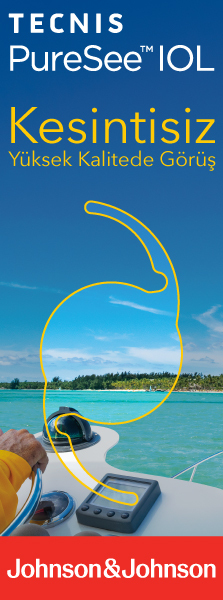2S.B. Ankara Atatürk Eğitim ve Araştırma Hastanesi 1. Göz Kliniği, Ankara, Doç. Dr.
3S.B. Ankara Atatürk Eğitim ve Araştırma Hastanesi 1. Göz Kliniği, Ankara, Prof. Dr. Purpose: To investigate the effects of cataract hardness on the parameters and complication rates of phacoemulsification surgery.
Materials and Methods: A total of 154 eyes in 154 patients who underwent phacoemulsification surgery under local anesthesia were assigned to one of two groups for the purpose of the study: a soft cataract group (SC) in which cataracts had a hardness of +1 or +2 (51 patients), and a hard cataract group (HC) in which cataracts had a hardness of +3 or +4 (103 patients). The groups were compared in phacoemulsification parameters (phaco time, phaco power and effective phaco time) and complication rates.
Results: Mean age in the SC group was 68.14±9.6 years, and in the HC group it was 71.03±8.9 years. Mean phaco-time in the SC group was 1.7±0.7 minutes, and in the HC group it was 3.0±1.1 minutes; while mean effective phaco-time in the SC group was 22.1±22.1 seconds, in the HC group it was found to be 46.2±24.0 seconds, and these differences were statistically significant (p<0.05). Mean phaco percentage in the SC group was 0.2±0.1, while in the HC group it was found to be 0.2±0.08, and the difference between the two groups was not statistically significant (p>0.05). In both groups a significant correlation was confirmed between cataract hardness and phaco-time (SC group r=0.317, p=0.023; HC group r=0.313, p=0.01). In terms of complications, in the SC group posterior capsule rupture (PCR) was seen in 4 patients (7.8%), and iris injury in 2 patients (3.9%). In the HC group, PCR was seen in 17 patients (16.5%), capsulorhexis discontinuity in 2 patients (1.9%) and iris injury in 1 patient (1%). In the HC group, moderate corneal edema was observed 16 patients (15.5%) and no corneal edema was observed in SC group. Surgical complications were significantly more frequent in the HC group (p<0.05). Conclusion: Increased cataract hardness caused both a lengthening of phaco-time and an increase in complication rate. So it will be more prudent to advise cataract patients to have early operation before cataract hardness reaches a challanging condition.
Keywords : Cataract hardness, phacoemulsification parameters, phacoemulsification




